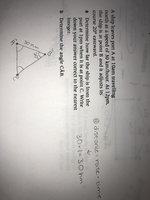Hello ap. Please ensure that you complete the request to read the
forum's guidelines. I like tkhunny's suggestion to start by drawing a diagram. That helps both to organize the given information and to assign symbols for unknown parts.
Three points form a triangle, yes? So we have triangle ABC in this exercise. In standard notation, we use an upper-case letter to name each vertex, and those symbols may also represent the angle measures. We then use the corresponding lower-case letter to name the side opposite a vertex, and that symbol may also represent the side's length. Here's what the diagram could look like (in my diagram, north is vertically upward):

Symbol a represents the length of the side opposite angle A
Symbol b represents the length of the side opposite angle B
Symbol c represents the length of the side opposite angle C
The first part of the exercise asks for the value of b, and the second part asks for the value of A.
As tkhunny hinted, we can use the distance formula to find the value of c and a because they've given us the starting and ending times for each segment, as well as the speed of the ship. Can you do that?
We can also find the value of B because the supplementary angle is given as 20º.
Once we have c, a, and B, we answer the questions using the Law of Cosines (for the first part) and the Law of Sines (for the second part).
Pro tip: To avoid round-off error, write down at least four decimal places, in your intermediate calculations (or use your calculator's memory to carry all digits). Do not round anything else until the very end.
Questions about any of this?
?



